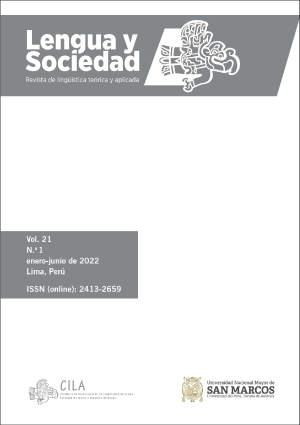The deictics aquí, acá, ahí, allí and allá in "Tell them not to kill me!" by Juan Rulfo
DOI:
https://doi.org/10.15381/lengsoc.v21i1.22528Keywords:
deictic, demonstratives, cognitive perspective, textual linguisticsAbstract
Rulfo's aesthetics explicitly presents us with the presence of demonstratives on the textual surface aquí, acá, ahí, allí and allá conjugated in the narrative, either manifested by the narrator or through the voice of the characters who adopt the rural perspective. Thus, in this article, we study the deictic system aquí, acá, ahí, allí and allá in the short story «Tell them not to kill me!» by Juan Rulfo from the perspective of the traditional system of deictics and the cognitive perspective raised by Stradioto and Maldonado (2018), with the aim of making explicit the dynamics and variabilities that these deictic systems acquire in the indicated story. For this purpose, the documentary method (Galeano, 2004) is used, which allows coding and systematizing precisely, and text tinguistics for the analysis of the deictics present in the textual surface of the mentioned story. Finally, it is concluded that the deictics present in the story «Tell them not to kill me!» present variability of meaning, a fact that corroborates the approach of Stradioto and Maldonado.
References
Aijón, M. y Serrano, M. (2010). Las bases cognitivas del estilo lingüístico. Sociolinguistic Studies, 4, 115-144. https://dialnet.unirioja.es/revista/12412/A/2010
Beaugrande, R. y Dressler, W. (1997). Introducción a la lingüística del texto. Editorial Ariel.
Bejarano, A. (2010). Los deícticos. Un problema para la semántica de Gottlob Frege. Discusiones Filosóficas, 11(17), 139-149. http://www.scielo.org.co/scielo.php?script=sci_arttext&pid=S0124-61272010000200008
Bernárdez, E. (1982). Introducción a la Lingüística del Texto. Espasa-Calpe.
Calsamiglia, H. y Tusón, A. (2001) Las cosas del decir. Manual de análisis del discurso. Editorial Ariel.
Cifuentes, J. (1989). Lengua y espacio. Introducción al problema de la deixis en español. Espagrafic.
Di Tullio, A. (2013). Ahí y por ahí en el español de la Argentina. Anuario de Letras. Lingüística y Filología, 1(2), 327-356. https://www.elsevier.es/en-revista-anuario-letras-linguistica-filologia-73-articulo-ahi-y-por-ahi-en-S0185137313702593
Flores, L. (2014). Los fenómenos lingüísticos que caracterizan a las protagonistas de Diez Mujeres de Marcela Serrano. Lingüística y Literatura, (66), 15-37. https://revistas.udea.edu.co/index.php/lyl/article/view/20209
Galeano, M. (2004). Diseño de proyectos en la investigación cualitativa. Universidad Eafit.
González, J. (1997). La estética del ruralismo en los cuentos de Juan Rulfo. En E. Valcarcel (Ed.), El cuento hispanoamericano del siglo XX. Teoría y práctica (pp. 201-212). Universidad de Coruña. http://hdl.handle.net/2183/9728
González, M. (1985). Manuel González Prada (Tomo I). Ediciones Copé.
González, M. y Morales, J. (2007). La salvación imposible o la ilusión de la vida eterna en ‘¡Diles que no me maten!’ de Juan Rulfo. Cartaphilus. Revista de Investigación y Crítica Estética, 1, 44-54. http://revistas.um.es/cartaphilus/article/view/78
Guerrero, G. (1995). La lingüística del texto y la pragmática lingüística. ELUA, (10), 443-446. http://rua.ua.es/dspace/handle/10045/6399
Hernández, R., Fernández, C. y Baptista, P. (2014). Metodología de la investigación. McGRAW-HILL.
Koch, I. G. V. (1997). Lingüística textual: retrospecto e perspectivas. ALFA: Revista De Linguística, 41, 67-78. https://periodicos.fclar.unesp.br/alfa/article/view/4012
López, S. (2005). Juan Rulfo: Su vida, su tiempo y su obra. Revista Iberoamericana, (16), 201-218. https://s-space.snu.ac.kr/simple-search?query=Juan+Rulfo
Lozano, A. (1988). Un análisis del uso de los deícticos en la comunicación verbal. Revista Española de Lingüística Aplicada, 4, 109-124. https://dialnet.unirioja.es/servlet/articulo?codigo=1961043
Maestro, J. (2017). Crítica de la Razón Literaria. Editorial Academia del Hispanismo.
Maldonado, R. (2013). Niveles de subjetividad en la deixis. El caso de aquí y acá. Anuario de Letras. Lingüística y Filología, 1(2), 283-326. https://www.elsevier.es/es-revista-anuario-letras-linguistica-filologia-73-articulo-niveles-subjetividad-deixis-el-caso-S0185137313702581
Martínez, M. (2004). Ciencia y arte de la metodología cualitativa. Trillas.
Miranda, E. (1985). La lingüística del texto y sus orientaciones. Revista Documentos Lingüísticos y Literarios, (11), 67-72. http://revistadll.cl/index.php/revistadll/article/view/388/525
Navarrete, M. y Félix, E. (2021). La estructura discursiva de denuncia en el cuento “Agua” de José María Arguedas. Lengua y Sociedad, 20(2), 359-382. https://doi.org/10.15381/lengsoc.v20i2.22257
Otaola, C. (2006). Análisis lingüístico del discurso: la Lingüística Enunciativa. Ediciones Académicas.
Palmira, M. (1998). El texto narrativo en la ficción escrita. Puntos de contacto entre lingüística y literatura. Estudios Filológicos, (33), 69-84. https://scielo.conicyt.cl/scielo.php?pid=S0071-17131998003300005&script=sci_arttext
Paz, Y. (2001). Deixis personal, social y discursiva en narrativas orales de El Empedrao (Maracaibo, Venezuela). Revista Signos, 34(49-50), 89-97. https://dx.doi.org/10.4067/S0718-09342001004900006
Real Academia Española. (2010). Manual de la Nueva Gramática de la lengua española. Espasa.
Rulfo, J. (2005). El llano en llamas. Fundación Juan Rulfo.
Sala, M. del C. (2020). Adjetivación en crónicas de Abraham Valdelomar. Lengua y Sociedad, 19(1), 51-89. https://doi.org/10.15381/lengsoc.v19i1.22317
Solari, O. A. (2021). Aspectos de los adverbios deícticos dimensionales de la lengua ashéninka del Alto Perené. Boletín de la Academia Peruana de la Lengua, 69(69), 201 - 233. https://doi.org/10.46744/bapl.202101.008
Stradioto, S. y Maldonado, R. (2018). Variables en un sistema deíctico binario: aquí, acá, ahí, allí y allá en el español de México. Nueva Revista de Filología Hispánica, 66(2), 395-423. https://doi.org/10.24201/nrfh.v66i2.3422
Ulloa, T. (2019). Instrumentos de análisis para caracterizar el comportamiento discursivo de la deixis espacial en relatos conversacionales. Sincronía, 23(76), 451-480. https://doi.org/10.32870/sincronia.axxiii.n76.23b19
Van Dijk, T. (1992). La ciencia texto. Cátedra.
Vicente, J. (1990). Deixis y conocimiento. Anales de Filología Hispánica, 5, 145-154. https://revistas.um.es/analesfh/article/view/57701/55591
Downloads
Published
Issue
Section
License
Copyright (c) 2022 Yan Carlos Gavilán Sierra, Flor Esther Rosario López

This work is licensed under a Creative Commons Attribution 4.0 International License.
AUTHORS RETAIN THEIR RIGHTS
a. Authors retain their trade mark rights and patent, and also on any process or procedure described in the article.
b. Authors can submit to the journal Lengua y Sociedad, papers disseminated as pre-print in repositories. This should be made known in the cover letter.
c. Authors retain their right to share, copy, distribute, perform and publicly communicate their article (eg, to place their article in an institutional repository or publish it in a book), with an acknowledgment of its initial publication in the journal Lengua y Sociedad.
d. Authors retain theirs right to make a subsequent publication of their work, to use the article or any part thereof (eg a compilation of his papers, lecture notes, thesis, or a book), always indicating its initial publication in the journal Lengua y Sociedad (the originator of the work, journal, volume, number and date).






